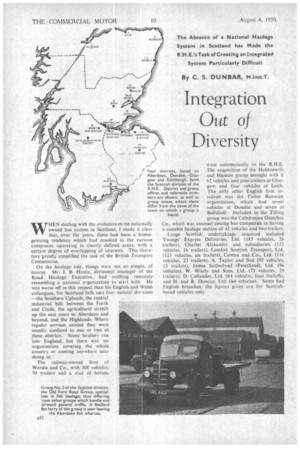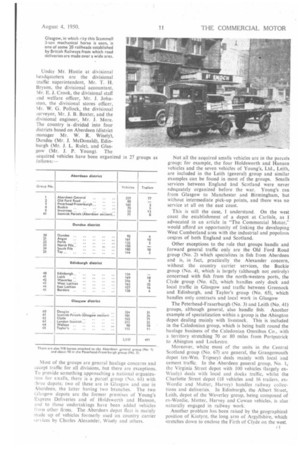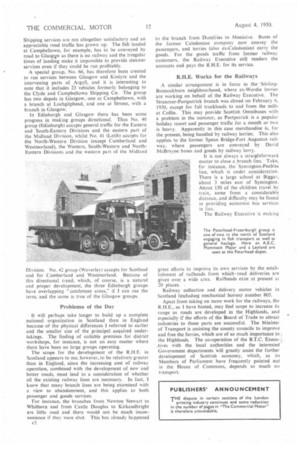Integration Out of Diversity
Page 34

Page 39

Page 40

If you've noticed an error in this article please click here to report it so we can fix it.
By C. S. DUNBAR, M.1 nst.T.
WHEN dealing with the evolution ot the nationally owned bus system in Scotland, I made it clear that, over the years, there had been a homo genizing tendency which had resulted in the various .companies operating in clearly defined areas. with a certain degree of overlapping of interests. This therefore greatly simplified the task of the British Transport
Commission. .
On the haulage side, things were not so simple, of course. Mr. J. B. Hastie, divisional manager of the Road Haulage Executive, had nothing remotely resembling a national organization to start with. He • was worse off in this respect than his English and Welsh colleagues, for Scotland falls into four natural div.sions
—the Southern Uplands, the central
.industrial belt between the Forth and Clyde, the agricultural stretch up the east coast to Aberdeen and beyond, and the Highlands. Where regular services existed they were usually confined to one or two of 'these districts. Some hauliers ran into England., but there was no organization covering. the whole country or coming anywhere near
doing so. .
The railway-owned firm of Wordie and Co., with 308 vehicles, 50 trailers and a stud of horses.
went automatically to the R.H.E. The acquisition of the Holdsworth and Hanson group brought with it 62 vehicles and nine trailers at Glasgow and four vehicles at Leith. The only other English firm involved was the Fisher Renwick organization, which had seven vehicles at Dundee and seven at Bellshiell. included in the Tilling group was the Caledonian Omnibus Co., which was unusual among bus companies in having a sizeable haulage section of 42 vehicles and two trailers.
Large Scottish undertakings acquired included Youngs' Express Deliveries, Ltd. (185 vehicles, 26 trailers), Charles Alexander and subsidiaries (132 vehicles, 16 trailers), London Scottish Transport, Ltd. (123 vehicles, six trailers), Cowan and Co., Ltd. (116 vehicles, 23 trailers), A. Taylor and Son (93 vehicles, 13 trailers), James Sutherland (Peterhead), Ltd. (96 vehicles), W. Wisely and Sons, Ltd. (73 vehicles, 20 trailers), D. Callander, Ltd. (64 vehicles, four trailers), and H. and R. Duncan, Ltd. (64 vehicles). Some had English branches; the figures given are for Scottishbased vehicles only.
Four districts, based on Aberdeen, Dundee, Glas
R.H.E. District and group offices and reference numbers are shown, as well as group names, where these differ from the name of the town on which a group is
based. Under Mr. Hastie at divisional headquarters are the divisional traffic superintendent, Mr. T. H.
Bryson, the divisional accountant, Mr. E. J. Crook, the divisional staff and welfare officer, Mr. J. Johnston, the divisional stores officer, Mr. W. G. Pollock, the divisional surveyor, Mr. J. B. Baxter, and the divisional engineer, Mr. J. More. The country is • divided into four districts based on Aberdeen (district manager Mr. W. R. Wisely), Dundee (Mr. J. McDonald), Edinburgh (Mr. J. L. Rule), and Glasgow (Mr. J. P. Young). The
acquired vehicles have been organized in 17 groups as follows:— Most of the groups are general haulage concerns and accept traffic for all divisions, hut there are exceptions. To provide something approaching a national organization for smalls, there is a parcel group (No. (21) with three depots; two of these are in Glasgow and one in Aberdeen, the latter having two branches. The two Cilaigow depots are the former premises of Young's Express Deliveries and of Holdsworth and Hanson, and to those undertakings have been added vehicles front other firms. The Aberdeen depot fleet is mainly made up of vehicles formerly used on country carrier ..,r‘ ices by Charles Alexander, Wisely and others.
Not all the acquired smalls vehicles are in the parcels group; for example, the four Holdsworth and Hanson vehicles and the seven vehicles of Young's, Ltd., Leith, are included in the Leith (general) group and similar examples can be found in most of the groups. Smalls services between England and Scotland were never adequately organized before the war. Young's ran from Glasgow to Manchester and Birmingham, but without intermediate pick-up points, and there was no service at all on the east coast.
This is still the case, I understand. On the west coast the establishment of a depot at Carlisle, as I advocated in an article in "The Commercial Motor,would afford an opportunity of linking the developing West Cumberland area with the industrial and populous cetures of both England and Scotland.
Other exceptions to the rule that groups handle and forward general traffic only are the Old Ford Road group (No. 2) which specializes in fish from Aberdeen and is, in fact, practically the Alexander concern, without the country carrier services, the Buckie group (No. 4), which is largely (although not ,entirely) concerned with fish from the north-western ports, the Clyde group (No. 62), which handles only dock and local traffic in Glasgow and traffic between Greenock and Edinburgh, and Taylor's group (No. 65), which handles only contracts and local work in Glasgow The Peterhead-Fraserburgh (No. 3) and Leith (No. 41) groups, although general, also handle fish. Another example of specialization within a group is the Abington depot dealing mainly with livestock. This is included in the Caledonian group, which is being built round the haulage business of the Caledonian Omnibus Co., with a territory stretching 70 or 80 miles from Portpatrick to Abington and Lockestre.
Moreover, whilst most of the units in the Central Scotland group (No. 67) arc general, the Grangemouth depot (ex-Wm. Tripney) deals mainly with local and cement traffic. In the Aberdeen general group, No. I,. the Virginia Street depot with 100 vehicles (largely exWisely) deals with local and docks traffic, whilst the Charlotte Street depot (18 vehicles and 16 trailers, exWordie and Mutter, Harvey) handles railway collections and deliveries. In Edinburgh, the Albert Street, Leith, depot of the Waverley group, being composed of ex-Wordie, Mutter, Harvey and Cowan vehicles, is also naturally engaged in railway work.
Another problem has been raised by the geographical position of Kintyre, the long arm of Argyllshire, which stretches down to enclose the Firth of Clyde on the west. Shipping services are not altogether satisfactory and an appreciable road traffic has grown up. The fish landed at Campbeltown, for example, has to be conveyed by road to Glasgqw as there is no railway and the irregular times of landing make it impossible to provide steamer services even if they could be run profitably.
A special group. No. 66, has therefore been created to run services between Glasgow and Kintyre and the intervening parts of Argyll, and it is interesting to note that it includes 23 vehicles formerly belonging to the Clyde and Carripbeltown Shipping Co. The group has two depots in Glasgow, one at Campbeltown, with a branch at Lochgilphead, and one at Strone, with a branch in Glasgow.
In Edinburgh and Glasgow there has been some progress in making groups directional. Thus No. 40 group (Edinburgh) accepts general traffic for the Eastern and South-Eastern Divisions and the eastern part of the Midland Division, whilst No. 41 (Leith) accepts for the North-Western Division (except Cumberland and Westmorland), the Western, South-Western and NorthEastern Divisions and the western part of the Midland
Division. No. 42 group (Waverley) accepts for Scotland and for Cumberland and Westmorland. Because of this directional trend, which, of course, is a natural and proper development, the three Edinburgh groups have overlapping "catchment areas," if I can use the term, and the same is true of the Glasgow groups.
Problems of the Day • It will perhaps take longer to build up a complete national organization in Scotland than in England because of the physical differences I referred to earlier and the smaller size of the principal acquired undertakings. The finding of suitable premises for district workshops, for instance, is not an easy matter where there have been no large groups operating.
The scope for the development of the R.H.E. in Scotland appears to me, however, to be relatively greater than in England, since the increasing cost of railway operation, combined with the development of new and better roads, must lead to a consideration of whether all the existing railway lines are necessary. In fact, I know that many branch lines are being examined with a view to abandonment, and this applies to both passenger and goods services.
For instance, the branches from Newton Stewart to VVhithorn and from Castle Douglas to Kirkcudbright are little used and there would not be much inconvenience if they were shut. This has already happened c2 to the branch from Dumfries to Moniaive. Buses of the former Caledonian company now convey the passengers, and lorries (also ex-Caledonian) carry the goods. For the goods traffic from former railway customers, the Railway Executive still renders the accounts and pays the R.H.E. for its service.
R.H.E. Works for the Railways
A similar arrangement is in force in the StirlingBannockburn neighbourhood, where ex-Wordie lorries are working on behalf of the Railway Executive. The Stranraer-Portpatrick branch was closed on February 6, 1950, except for full truckloads to and from the mills at Coffin. This may provide Scottish Omnibuses with a problem in the summer, as Portpatrick is a popular holiday resort and passenger traffic for a month or two is heavy. Apparently in this case merchandise is, for the present, being handled by railway lorries. This also applies to the former Spean Bridge-Fort Augustus railway, where passengers are conveyed by David McBrayne buses and goods by railway lorry.
It is not always a straightforward matter to close a branch line. Take, for instance, the Symington-Peebles line, which is under consideration. There is a large school at Biggar, about 3 miles east of Symington. About 150 of the children travel by train, some from a considerable distance, and difficulty may be found in providing economic bus services in lieu.
The Railway Executive is making
great efforts to improve its own services by the establishment of railheads from which, road deliveries are given over a wide area. Railheads exist at present at 20 places.
Railway collection and delivery motor vehicles in Scotland (including mechanical horses) number 805.
Apart from taking on more work for the railways, the R.H.E., as I have hinted, may find scope to increase its range as roads are developed in the Highlands, and especially if the efforts of the Board of Trade to attract industries to those parts are successful. The Minister of Transport is assisting the county councils to improve and free the ferries, which are of so much importance to the Highlands. The co-operation of the B.T.C. Execu-fives with the local authorities and the interested Government departments Will greatly assist the further development of Scottish economy, which, as its Members of Parliament have frequently pointed out in the House of Commons, depends so much on transport.




















































































